The “next generation consumer Quest” will launch “later next year”, Meta’s CFO told investors.
During Meta’s Q3 2022 earnings call, Susan Li mentioned the headset while warning investors of increasing costs next year:
“Conversely, our growth in cost of revenue is expected to accelerate, driven by infrastructure-related expenses and, to a lesser extent, Reality Labs hardware costs driven by the launch of our next generation of our consumer Quest headset later next year.”
Reality Labs is the division of Meta behind Quest headsets, smart glasses, Meta Avatars, Horizon, and research & development towards future devices such as the neural wristband project and AR glasses.
Earlier this month Mark Zuckerberg told Stratechery “there will be a Quest 3 and that’s in the price range of $300, $400, or $500, that zone”, but said it isn’t launching this year. He first confirmed Quest 3 was in development in an interview last year. Quest 2 is the current consumer Quest so given Zuckerberg’s comments, Li is almost certainly referring to Quest 3.
Li’s reference to cost growth suggests this $300-$500 price will be achieved through subsidization, just as Quest 2’s $300 launch price was.
So what do we know about Quest 3 so far, and what has been apparently leaked?
During Connect 2022, “Consulting CTO” John Carmack said Meta’s future headsets, presumably including Quest 3, will support 120Hz refresh rate.
Late last month apparent schematics of Quest 3 were leaked to YouTuber SadlyItsBradley (Brad Lynch). Unlike the just-released Quest Pro, the headset depicted didn’t have either eye or face tracking. It did, however, have a slimmer design than Quest 2 achieved with pancake lenses, and a depth sensor for mixed reality. It’s possible though that Meta has multiple prototype candidates for Quest 3, and the headset seen in that leak is just one of them.

Quest 3’s biggest apparent improvement isn’t something you’d see in schematics though. Current mainstream standalone headsets – including Quest 2 and Pico 4 – use the first XR2, which was recently retroactively labeled Gen 1 by Qualcomm. XR2 Gen 1 is a variant of the Snapdragon 865 smartphone chip that first shipped in early 2020. But Qualcomm has since followed up the 865 line with two new generations, 888 and 8 Gen 1 (the company changed the naming scheme with the release of the latest model).
Meta & Qualcomm recently announced a multi-year partnership to build next-generation Snapdragon XR chipsets, and a source of Lynch told him Quest 3 will use the yet-to-be-announced Snapdragon XR2 Gen 2.
Import logs indicate XR2 Gen 2 is based on Snapdragon 8 Gen 2, expected to be announced at the Snapdragon Summit next month. If the new chipset’s GPU offers even a modest performance leap over 8 Gen 1, Quest 3’s GPU will be at least twice as powerful as Quest 2’s. This would enable higher fidelity graphics on higher resolution displays – and perhaps even entirely new games that simply wouldn’t be possible on Quest 2.
Meta announced Quest 2 and Quest Pro at its yearly Connect conference, which takes place around October. “Later next year” suggests Connect 2023 is when Quest 3 should be announced.
Meta declined to comment beyond what was said in the earnings call.





